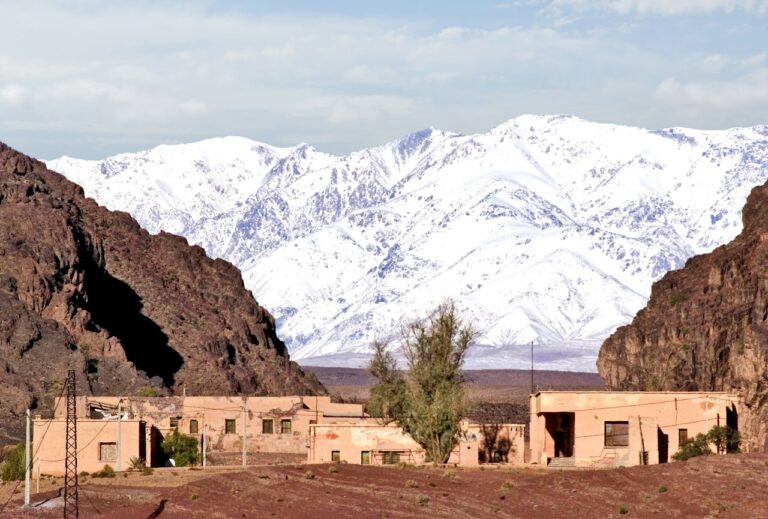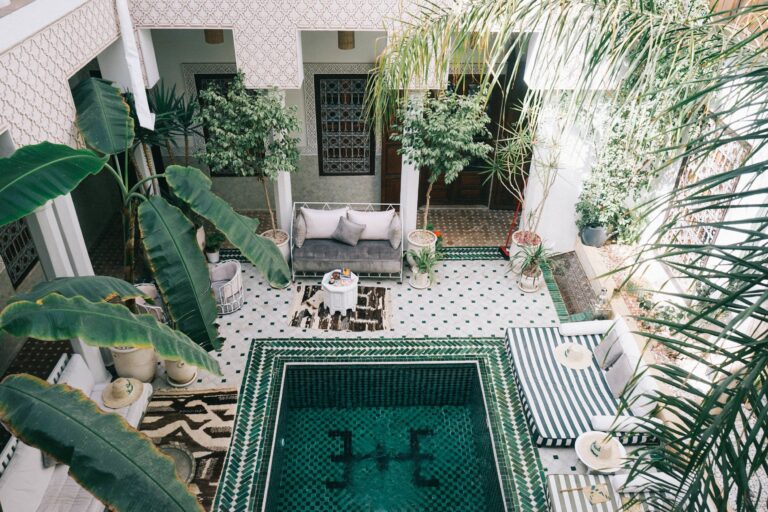
Moroccan souks, or traditional marketplaces, are one of the most vibrant aspects of the country’s culture and travel experience. These bustling hubs of commerce offer an unforgettable sensory overload, from the dizzying array of colors to the intoxicating scents of spices, herbs, and freshly baked bread. Whether you’re a seasoned traveler or a first-time visitor, exploring Morocco’s souks is a must for anyone wanting to experience the heart of its ancient traditions, craftsmanship, and local life.
In this article, we’ll take a deep dive into the top 5 Moroccan souks that you need to visit, offering you a unique glimpse into the country’s rich history, culture, and artistry.
1. Souk Semmarine – Marrakech
The Heart of Marrakech’s Medina
Marrakech is famous for its vibrant medina (old city), and at the very heart of this labyrinthine district lies Souk Semmarine. This souk is arguably one of the most iconic markets in all of Morocco and is a must-visit for any traveler looking to experience the essence of Moroccan commerce and craftsmanship.
What to Expect
- Handcrafted Goods: Souk Semmarine is packed with artisans selling an incredible variety of handcrafted goods, including intricate leather products like bags, belts, and shoes, as well as metalwork, wood carvings, and hand-painted ceramics. The souk is especially famous for its beautifully detailed Moroccan lanterns, which glow with a soft, warm light that’s perfect for adding a touch of Morocco to any home.
- Textiles & Fabrics: The souk also boasts a range of fabrics, from richly patterned silks and cotton scarves to Berber rugs and poufs. Each textile piece has its own distinct style, often reflective of the different regions and traditions of Morocco.
- Bargaining: Like most Moroccan souks, Souk Semmarine is a place where bargaining is both expected and encouraged. Be prepared to haggle for the best price while soaking in the vibrant atmosphere of the market.
- Spices & Perfumes: As you wander through the narrow alleys of Souk Semmarine, you’ll encounter numerous spice stalls offering colorful piles of saffron, cumin, paprika, and mint, as well as shops selling fragrant essential oils and Moroccan perfumes.
Why Visit?
Souk Semmarine is a great place to experience the authenticity of Marrakech’s medina while purchasing unique souvenirs that showcase Moroccan craftsmanship. With its wide range of goods, it’s the perfect souk for visitors who want a comprehensive Moroccan shopping experience.
2. Souk El Had – Agadir
The Largest Souk in Southern Morocco
Located in Agadir, a coastal city known for its laid-back atmosphere and beautiful beaches, Souk El Had is the largest and one of the most well-organized souks in Morocco. Unlike the chaotic markets of Marrakech, Souk El Had offers a more relaxed, yet equally vibrant, shopping experience.
What to Expect
- Fresh Produce: This souk is particularly well-known for its fresh fruits and vegetables. If you’re a fan of Moroccan food or cooking, this is the place to find the best local produce, from pomegranates and oranges to olives and figs. The market is also filled with stalls selling dried fruits, dates, and nuts, which make excellent snacks or souvenirs.
- Handmade Crafts: You’ll find plenty of traditional woodwork, ceramics, and textiles in Souk El Had, much of it produced by local artisans from the surrounding areas. It’s a great place to pick up souvenirs like wooden spoons, woven baskets, and embroidered fabrics.
- Spices and Herbal Remedies: The souk is a haven for those interested in Moroccan spices, herbs, and natural remedies. From henna to cumin, ginger, and chili powder, this is the place to stock up on Moroccan flavors. The herbal shops also sell medicinal plants used in traditional remedies, which are central to Moroccan health practices.
Why Visit?
If you’re visiting Agadir or the southern region of Morocco, Souk El Had offers a more relaxed and less touristy atmosphere compared to other souks in major cities. It’s ideal for those wanting to experience a more local and authentic side of Morocco’s trading culture.
3. Souk Al-Attarine – Fez
The Soul of Fez’s Historic Medina
Fez, one of Morocco’s oldest and most culturally significant cities, is home to some of the best-preserved examples of medieval Arab-Islamic architecture and is a UNESCO World Heritage site. Souk Al-Attarine is located near the famous Al-Qarawiyyin University, making it a key stop in Fez’s historic medina.
What to Expect
- Spices & Perfumes: Souk Al-Attarine is one of the best places in Morocco to shop for spices and perfumes. The scent of rosewater, saffron, amber, and essential oils fills the air, and the variety of herbs, spices, and flowers used in Moroccan cuisine and cosmetics is mind-boggling.
- Traditional Medicine: In this souk, you’ll also find stalls dedicated to herbal remedies and essential oils used in Moroccan beauty treatments and traditional medicine. You can buy everything from argan oil (a local Moroccan treasure) to black soap and kohl for eyeliner.
- Brass and Copperware: One of the most unique features of Souk Al-Attarine is its stunning brass and copper work. You’ll find intricately designed lanterns, trays, and bowls—perfect for adding a touch of Moroccan elegance to your home decor.
Why Visit?
Souk Al-Attarine offers a glimpse into Fez’s long-standing history as a center of trade, knowledge, and culture. The souk’s focus on spices, perfumes, and traditional remedies makes it a must-see for those interested in the rich flavors and scents that define Moroccan life.
4. Souk Joute – Marrakech
A Hidden Gem in the Medina
Tucked away in a quieter area of Marrakech’s medina, Souk Joute is a smaller, lesser-known souk compared to the larger, more famous Souk Semmarine. However, it’s a hidden gem for those seeking unique artisanal goods and a more intimate shopping experience.
What to Expect
- Handmade Carpets & Rugs: This souk specializes in traditional Berber carpets and kilims (flat-woven rugs). Each rug tells a story, often woven with symbols and patterns that represent the maker’s tribe and heritage.
- Pottery & Ceramics: Souk Joute is known for its exquisite Moroccan ceramics. You’ll find hand-painted plates, bowls, jugs, and vases that make great souvenirs or gifts.
- Leather Goods: The souk also offers high-quality leather products, including wallets, bags, and slippers (known as babouches). The craftsmanship of leatherwork in Morocco is world-renowned, and Souk Joute provides a more relaxed environment to browse and purchase these beautifully made items.
Why Visit?
Souk Joute offers a more off-the-beaten-path experience compared to the larger souks in Marrakech. It’s perfect for those seeking high-quality Moroccan handicrafts, particularly rugs and ceramics, and for anyone wanting to escape the larger crowds.
5. Souk of the Medina – Chefchaouen
The Blue Paradise of Morocco
Chefchaouen, the “Blue City” of Morocco, is a charming mountain town famous for its distinctive blue-painted buildings and tranquil atmosphere. The souks here are smaller than those in cities like Marrakech or Fez, but they still offer a wealth of traditional goods.
What to Expect
- Textiles & Handicrafts: The souk in Chefchaouen is the perfect place to shop for colorful handwoven blankets, scarves, and ponchos, often made from wool and cotton. The town’s artisans are known for their attention to detail and quality craftsmanship.
- Pottery: Chefchaouen is also renowned for its beautiful pottery, often painted in the signature blue tones that are so characteristic of the town. You can find ceramic bowls, plates, and mugs that make for wonderful souvenirs.
- Local Spices: The souk offers a range of local spices and herbs, many of which are grown in the surrounding Rif Mountains. You’ll also find Moroccan mint tea and a variety of herbal remedies in the stalls.
Why Visit?
The souk of Chefchaouen offers a more relaxed, charming experience compared to the larger, busier markets in other Moroccan cities. It’s a wonderful place to buy local textiles, pottery, and handicrafts, all within the stunning blue backdrop of the city.
FAQs : Exploring Moroccan Souks
Moroccan souks are more than just markets; they are living, breathing cultural experiences. Each souk offers its own unique treasures and opportunities for visitors to immerse themselves in the rich traditions
1. What is a souk in Morocco?
A souk is a traditional market or bazaar in Morocco, typically found in the medinas (old towns) of major cities. Souks are bustling hubs of commerce where locals and tourists alike can buy a variety of goods, from spices and textiles to pottery, jewelry, and handcrafted items. The souk is an integral part of Moroccan culture, offering a vibrant, sensory experience.
2. What should I buy in Moroccan souks?
Moroccan souks are known for their wide range of traditional goods, including:
- Spices: Saffron, cumin, paprika, and Moroccan spice blends.
- Handicrafts: Leather goods (bags, slippers), brass and copper items (lanterns, trays), and ceramics.
- Textiles: Moroccan rugs, scarves, blankets, and clothing.
- Jewelry: Silver and gold pieces with intricate designs.
- Perfumes: Traditional Moroccan oils and perfumes.
- Tea Sets: Beautifully designed Moroccan teapots and glasses.
3. Are the prices in Moroccan souks negotiable?
Yes, bargaining is a common practice in Moroccan souks. Prices are typically not fixed, and the initial price is often higher than what the seller is willing to accept. It’s part of the experience, and sellers generally expect visitors to negotiate. However, it’s important to be respectful and understand the value of the items you’re purchasing.
4. How do I navigate Moroccan souks?
Navigating Moroccan souks can be challenging due to their narrow, winding alleyways and dense crowds. Here are a few tips:
- Take your time: Walk slowly and enjoy the sights, sounds, and smells.
- Stay oriented: Familiarize yourself with landmarks to help you get your bearings, as it’s easy to get lost in the medina.
- Trust your instincts: If a path feels too crowded or uncomfortable, try another route.
- Ask for directions: If you get lost, don’t hesitate to ask a local for directions—many Moroccans are helpful and friendly.
5. When is the best time to visit the souks?
The best time to visit Moroccan souks is in the morning, when the markets are less crowded and the temperatures are cooler. However, some souks are especially busy during evenings and weekends. If you prefer a quieter experience, try visiting early in the day on weekdays.
6. Is it safe to shop in Moroccan souks?
Yes, Moroccan souks are generally safe, but like any crowded market, it’s important to be aware of your surroundings. Keep your belongings secure, and avoid carrying large amounts of cash or expensive items. Be cautious of pickpockets, especially in heavily crowded areas.
7. Should I bring cash to the souk?
Yes, it’s advisable to bring cash, as most souks do not accept credit cards. Moroccan dirhams (MAD) are the local currency, and smaller vendors typically prefer cash payments. ATMs are available in major cities, but it’s always best to carry cash when shopping in the souks.
8. Are Moroccan souks open every day?
Most souks are open daily, but the opening hours can vary depending on the city and the time of year. Generally, souks open in the morning and close by sunset. In tourist-heavy cities like Marrakech and Fez, souks may stay open later, especially in the evenings.
9. What is the best way to get to a souk?
Souks are typically located in the heart of a city’s medina, which is often pedestrianized and may be difficult to access by car. The best way to get to a souk is by walking. If you’re staying outside the medina, you can hire a local guide or take a taxi to the nearest entrance to the medina. Once inside, most souks are within walking distance from each other.
10. What are some common scams in Moroccan souks?
While Moroccan souks are generally safe, it’s important to be aware of potential scams, especially in busy tourist areas. Common scams include:
- Overcharging: Vendors may inflate prices, expecting you to negotiate.
- Fake guides: Some individuals offer to show you around or lead you to a shop, only to demand a commission.
- Street performers: In some areas, performers may ask for money after taking your photo or involving you in their act.
To avoid these scams, always negotiate prices up front, be cautious about unsolicited help, and use common sense.
11. Can I find souvenirs in Moroccan souks?
Absolutely! Souks are the perfect place to buy authentic Moroccan souvenirs. From handmade pottery and leather goods to traditional Moroccan tea sets, you’ll find unique and locally-made items that make for memorable gifts or keepsakes.
12. Are Moroccan souks wheelchair accessible?
Most Moroccan souks, especially those in older cities like Fez and Marrakech, are not very wheelchair-friendly. The narrow, uneven streets and high curbs make it challenging to navigate with a wheelchair or stroller. If accessibility is a concern, it’s best to explore souks that are less crowded and more organized, like Souk El Had in Agadir, which is larger and more spacious.
13. What should I wear when visiting Moroccan souks?
Morocco is a predominantly Muslim country, so it’s respectful to dress modestly when visiting souks, especially in smaller towns or rural areas. Women should avoid wearing revealing clothing, and men should avoid walking around in shorts. Comfortable shoes are essential for walking through the cobbled streets and narrow alleyways of the souks.






